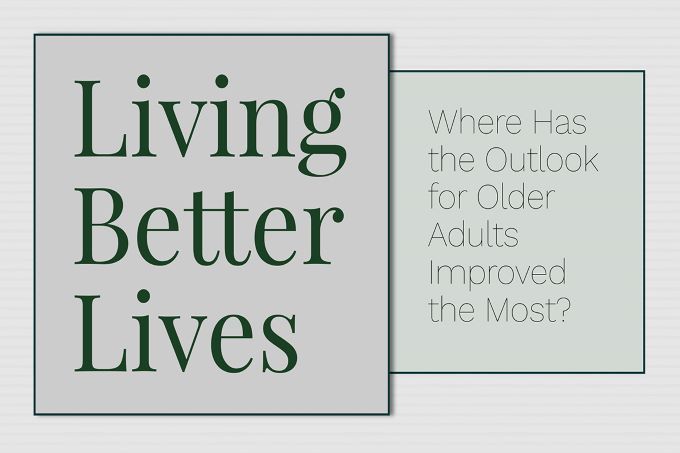States with the Most Improved Outlook for Older Adults
Discover the most and least improved states for older adults in the US. Seniorly offers insight into where things have gotten better for seniors.

The COVID-19 pandemic has resulted in a decline in life expectancy for Americans, a two-year drop between 2019 and 2020, the biggest single-year decline since World War II. But, the pandemic aside, older Americans are in many ways living better for longer than they were even just a half-decade ago.
Our analysis found that despite the recent drop in life expectancy, many of the problems common among older adults have eased over the past decade. For example, death rates from diseases like COPD, cancer, and heart disease, all of which are top causes of death for the elderly, have dropped. Meanwhile, the average Social Security check has climbed (even after accounting for inflation), and fewer older people are experiencing issues that exacerbate social isolation, including living alone and lacking internet access.
We’ve looked at which states are best for older workers or single seniors, but we wanted to explore which states have seen the lives of seniors improve the most over the past decade — and which ones are falling behind.
To do this, we compared data for all 50 states and the District of Columbia in four broad categories: physical health, mental health, finances, and social factors. Within those broad categories, we examined federal data to determine how metrics have changed for better (or worse) in each state. (See the full methodology at the bottom of this page.)
Here are some key findings:
- Washington was the top state overall when it comes to providing a better life for older adults, while North Dakota was second, and Massachusetts was third. Nevada had the worst score, followed by Michigan and Utah.
- D.C. had the biggest average decline in death rates from causes of death that disproportionately affect older adults, while Utah had the biggest average increase.
- Vermont had a 26 percent decrease in the suicide rate among older adults since 2011, while Montana had a 72 percent increase in the rate.
Best and worst states
For the purposes of this analysis, we compared the states across these four major categories — physical health, mental health, finances, and social factors — with all categories having at least two individual metrics. A total of 12 individual ranking factors were included, and states were awarded points based on their rank in each factor, with a best possible score of 306.
While no states reached that lofty goal, a couple of them got fairly close. Washington was the top state overall, scoring 248.8, just two points ahead of second-place finisher, North Dakota. Washington’s winning performance was powered by its strength across three of the four categories, ranking second in physical health and social factors and fifth in finances.
At the other end of the spectrum, Nevada had the nation’s lowest score, about 10 points behind Michigan. Nevada was the second worst for physical health, ranked in the bottom 15 for social factors and finances and was in the middle of the pack for mental health.
Notably, several states traditionally considered popular destinations for older adults weren’t rated highly in our analysis. Florida, for example, which has long been thought of as a primary retirement destination, was in the middle of the pack. This is likely due to the nuances of our analysis, which sought to determine which states have made the most progress when it comes to improving the lives of older adults. So, that means a state like Florida probably didn’t have as far to go as others.

Death rates from cancer call in all states, while heart disease drops in most
COVID-19 was the third leading cause of death in the U.S. in 2020, with only heart disease and cancer causing more deaths. All three causes of death are much more common for those over 65, along with Alzheimer’s disease, COPD, and diabetes, which are all top-five causes of death (if you take COVID-19 out of the equation).
We calculated the rate of change for all five top causes of death for those 65 and older (Alzheimer’s disease, cancer, COPD, diabetes, and heart disease) over the past decade to determine which states are making the most progress in fighting these diseases. For the purposes of our final analysis, we averaged the rate of change for all five diseases and weighted each state’s score in this area by a factor of 2.5, given the importance of physical health.
We did not include life expectancy in our analysis because, as we’ve touched on, it’s falling instead of going up. That said, the past century has seen U.S. life expectancy rise by more than 30 years, going from 54 in 1920 to 77 in 2020.
Because of the weight we gave physical health in our formula, most of the states that performed best in this category found themselves near the top of the list for best states overall. D.C. had the biggest drop in average death rates from the five diseases, while Washington was second and Vermont and Massachusetts tied for fourth.

Most states see poor mental health, suicides rise for older adults
Mental well-being is a crucial component to living well, but recent years have seen a rise in poor mental health, both in the U.S. and across the world. In this area, unfortunately, few states are doing well when it comes to mental health for older adults.
We considered two factors in this category — the percentage of older adults who reported having no bad mental health days in the past month and the age-adjusted rate of death by suicide for those 65 and older.
Only 13 states have seen the rate of suicides among older adults fall in the past decade, while only five states showed improvements in the share of older adults who report not having any bad mental well-being days. Only one state — Maine — saw both categories move in the right direction, and even then, the changes were in the single digits.

Social Security checks rise in all states, but majority also see poverty increase
When it comes to the financial well-being of older adults, our analysis shows a mixed bag. On the one hand, every state has seen an inflation-adjusted increase to monthly Social Security retirement checks, but more than half have also seen the percentage of people 65 and older who fall below the poverty line.
A couple of states are on the good side in both of the financial measures we considered — both South Dakota and North Dakota had top-10 improvements in the share of seniors in poverty and in the average retirement check increase.

Share of older adults rises in all states, while most have seen rate of seniors living alone decline
Remaining connected with friends, family, and the broader community is crucial as we age. Recent studies have found that social isolation increases the risk of premature death by a factor similar to that of smoking.
To determine which states have made the most progress when it comes to preventing social isolation of older adults, we analyzed changes in these categories: the share of older adults per 100,000 residents, the percentage of people 65 and older living alone, and the percentage of older adults without internet access.
All states have seen their population-adjusted rate of older adults rise over the past decade, while all but five have seen the share of seniors living alone fall in that time. The percentage of residents 65 and older without access to the internet has declined in all but 10 states, but in this area, we were only able to compare the change since 2015, as data from a decade ago was not available. So, it’s likely all states have seen an improvement in this rate since 2011.

Conclusion
Because conditions may be improving for older adults in many states, that doesn’t necessarily mean they’re ideal landing spots for retirement. However, understanding where older adults are most likely to face fewer barriers to good health of all types can help individuals and families make informed decisions.
Methodology
We compared the 50 states and the District of Columbia across 12 metrics in four broad categories. Here’s a look at the categories and sources we used:
Physical health
We compared the age-adjusted rates of the top five causes of death of older adults (excluding COVID-19), which are Alzheimer’s disease, cancer, COPD, diabetes, and heart disease for the years 2011 and 2020. This data came via a custom query to the CDC’s WONDER database.
Mental health
We compared the age-adjusted rates of suicide among those 65 and older for the years 2011 and 2020 using a WONDER query, as well as the percentage of older adults reporting having no bad mental health days in the past month for the years 2011 and 2020. This figure came via a custom query of the CDC’s Behavioral Risk Factor Surveillance System.
Finances
We compared the change in the average monthly Social Security retirement benefit for 2011 and 2020, adjusting the 2011 figures for inflation at a cumulative rate of 15 percent. We also calculated the change in the share of older adults below the poverty line in each state with data from the U.S. Census Bureau for the years 2011 and 2020.
Social factors
Using data from the U.S. Census Bureau, we analyzed how the risk of social isolation for older adults has changed via these three metrics: householders 65 and older living alone, people 65 and older without internet access, and residents 65 and older per 100,000 people.
Each state’s rank across the individual metrics was averaged within their categories and those ranks were then added together. We used a formula that weighed physical health at 2.5 times its value, finances at 1.5 times its value, and the other two categories at their full value. As a result, the highest possible score a state could receive was 306.
To use nation-leading Washington as an example:
- Physical health: 125 points
- Mental health: 20.5 points
- Finances: 62.3 points
- Social factors: 41 points
Stephen has been a digital marketing, sales, and operations leader. A strategist at heart, he has built high performing solutions for brands large and small across challenging industries such as Insurance, Travel, and Personal Finance. As Seniorly's Chief Strategy Officer, Stephen draws on this experience to help families and senior living communities connect with the best possible outcomes. Originally from the north east, Stephen enjoys playing on the mountains and beaches of California with his wife, son and daughter.
To learn more about Seniorly's editorial guidelines, click here.
Sign up for our Healthy Aging Handbook
Seniorly’s Senior Living experts created a comprehensive handbook to help people age happily while ensuring they love where they live. Enter your email address below to receive your copy and learn more about Healthy Aging and Senior Living.*
*By submitting your email address above, you consent to receive occasional email communications from Seniorly, including educational content and tips, newsletters, and other relevant updates and offerings. You can unsubscribe at any time and we will never sell or distribute your email address to a third party. You can view our Privacy Policy here.
